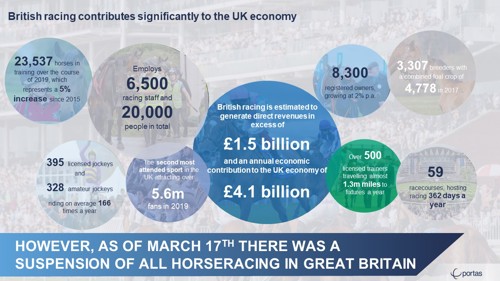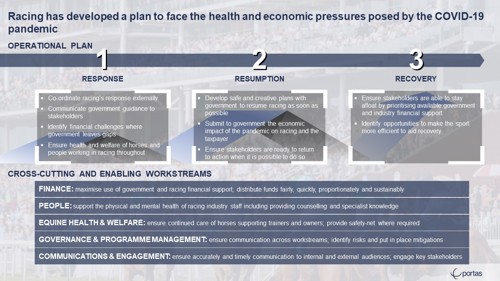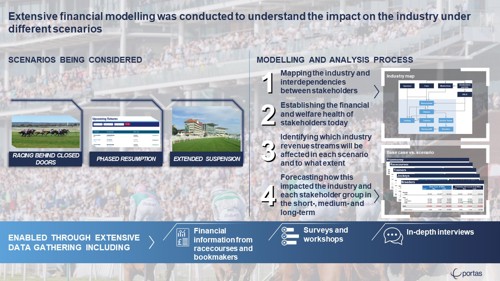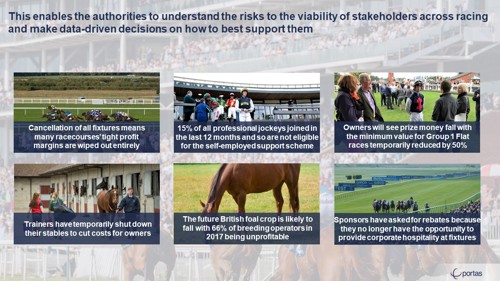Horseracing contributes significantly to the UK economy. It draws the 2nd highest number of spectators of any sport in the UK, employs over 20,000 people and provides GBP 4.1 billion to the UK economy. However, the COVID-19 pandemic has required the industry’s leadership to suspend racing on 17th March and develop a comprehensive action plan to tackle the financial and welfare challenges the industry now faces. This includes using industry funds effectively to mitigate the financial impact on stakeholders; developing options to return to racing when the time is right; ensuring frequent communications to industry participants; and developing a compelling case to government on the economic impact of the pandemic.


The British Racing Industry Group has developed a 3-part plan in the wake of COVID-19: Response, Resumption and Recovery. Firstly, Response pertains to the flexibility with which British Racing reacts to government advice to play its part in the national effort to solve the crisis, whilst addressing immediate needs to support the welfare of people and horses alike. The Industry Group also understand the importance of a swift Resumption to racing and are developing creative strategies which could provide racing with a first-mover advantage. All plans are designed to be flexible enough to respond to local variations in the provision of health services and continuing social and sporting restrictions. Finally, accepting that significant resource will be required as part of the Recovery process to ensure stakeholder groups remains afloat forces the industry to proactively make funds and reserves available.
This 3-part plan is being delivered through five workstreams: Financial, People, Equine Health & Welfare, Governance & Programme Management and Communications & Engagement.

Detailed calculations on the economic impact of the pandemic for any sport is complicated. Planning and modelling for British Racing was particularly complicated, given the complexity of the industry landscape and number of interdependencies between stakeholder groups. The modelling was a detailed, fact-based exercise, involving extensive cross-industry collaboration. Data was gathered from racecourses, bookmakers, and many individual stakeholders. The analysis was undertaken across 3 scenarios: continuing racing behind closed doors, phased resumption and extended suspension and measured the impact of each scenario on the economics of the sport, determining the potential revenue losses to the industry and its consequent impact on profitability of the sector and on each stakeholder group.

This rigorous process was key to securing broad-based alignment among all stakeholders in racing and forms a strong base for informed discussions with the government on supporting the sector. For instance, it clearly highlights the high fixed-cost nature of racing, quantifies the wide-ranging impact that the suspension can have and details the significant risk to the immediate viability of certain segments such as trainers, owners, racecourses, jockeys and breeders.

The ability to quickly gain agreement from a complex set of stakeholders for the comprehensive plan was down to 3 success factors:
- Co-ordinated response with significant involvement across the whole racing industry - from grassroots workforce to facility owners, commercial partners and senior leaders- providing a strong platform to resume and recover as quickly as possible
- Customer and stakeholder communication with open dialogue and acknowledgement of challenges across the value chain with a clear direction for all in the sport and identification of gaps and intervention areas requiring government support
- Comprehensive scenario planning and analysis based on up-to-date information centrally coordinated and a thorough understanding of the interdependencies between everyone, considering a range of time spans for COVID-19 restrictions to be in place and the conditions under which racing could partially and fully resume
